常减压蒸馏过程实时动态模拟
- 格式:pdf
- 大小:939.27 KB
- 文档页数:4
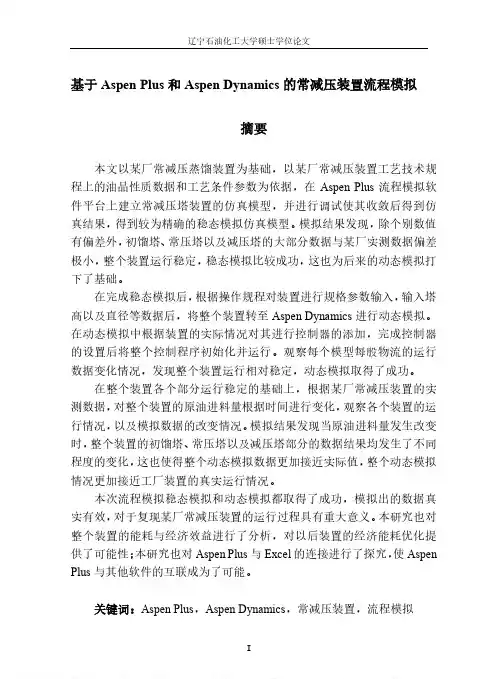
基于Aspen Plus和Aspen Dynamics的常减压装置流程模拟摘要本文以某厂常减压蒸馏装置为基础,以某厂常减压装置工艺技术规程上的油品性质数据和工艺条件参数为依据,在Aspen Plus流程模拟软件平台上建立常减压塔装置的仿真模型,并进行调试使其收敛后得到仿真结果,得到较为精确的稳态模拟仿真模型。
模拟结果发现,除个别数值有偏差外,初馏塔、常压塔以及减压塔的大部分数据与某厂实测数据偏差极小,整个装置运行稳定,稳态模拟比较成功,这也为后来的动态模拟打下了基础。
在完成稳态模拟后,根据操作规程对装置进行规格参数输入,输入塔高以及直径等数据后,将整个装置转至Aspen Dynamics进行动态模拟。
在动态模拟中根据装置的实际情况对其进行控制器的添加,完成控制器的设置后将整个控制程序初始化并运行。
观察每个模型每股物流的运行数据变化情况,发现整个装置运行相对稳定,动态模拟取得了成功。
在整个装置各个部分运行稳定的基础上,根据某厂常减压装置的实测数据,对整个装置的原油进料量根据时间进行变化,观察各个装置的运行情况,以及模拟数据的改变情况。
模拟结果发现当原油进料量发生改变时,整个装置的初馏塔、常压塔以及减压塔部分的数据结果均发生了不同程度的变化,这也使得整个动态模拟数据更加接近实际值,整个动态模拟情况更加接近工厂装置的真实运行情况。
本次流程模拟稳态模拟和动态模拟都取得了成功,模拟出的数据真实有效,对于复现某厂常减压装置的运行过程具有重大意义。
本研究也对整个装置的能耗与经济效益进行了分析,对以后装置的经济能耗优化提供了可能性;本研究也对Aspen Plus与Excel的连接进行了探究,使Aspen Plus与其他软件的互联成为了可能。
关键词:Aspen Plus,Aspen Dynamics,常减压装置,流程模拟Process simulation of atmospheric and vacuum distillation unit based on Aspen Plus and Aspen DynamicsABSTRACTIn this thesis, based on the atmospheric and vacuum distillation unit in a plant, the oil property data and process condition parameters in the process specification of atmospheric and vacuum unit in a plant are used as the basis, and the simulation model of atmospheric and vacuum tower unit is established on Aspen Plus process simulation software platform. After debugging, the simulation results are obtained after convergence, and a more accurate steady-state simulation model is obtained. The simulation results show that most of the data of the primary distillation tower, atmospheric pressure tower and pressure reducing tower have little deviation from the measured data of a certain plant, the whole unit runs stably and the steady-state simulation is relatively successful, which also lays a foundation for the later dynamic simulation.After the completion of the steady-state simulation, the specification parameters of the device are input according to the operation procedures, and the tower height and diameter data are input, the whole device is transferred to Aspen Dynamics for dynamic simulation. In the dynamic simulation, the controller is added according to the actual situation of the device. After the controller is set, the whole control program is initialized and run. By observing the operation data of each model, it is found that the operation of the whole device is relatively stable and the dynamic simulation is successful.On the basis of stable operation of each part of the whole unit, according to the measured data of atmospheric and vacuum unit in a certain plant, the crude oil feeding amount of the whole unit changes according to time, and the operation of each unit is observed, as well as the change of simulation data. Thesimulation results show that when the crude oil feed quantity changes, the data results of the primary distillation tower, atmospheric pressure tower and pressure reducing tower of the whole unit have changed in varying degrees, which also makes the whole dynamic simulation data closer to the actual value and the whole dynamic simulation situation closer to the real operation of the plant.The steady-state simulation and dynamic simulation of this process have been successful, and the simulated data are real and effective, which is of great significance for the recurrence of the operation process of atmospheric and vacuum distillation unit in a plant. This study also analyzes the energy consumption and economic benefits of the whole device, and provides the possibility for the optimization of the economic energy consumption of the device in the future; this study also explores the connection between Aspen Plus and excel, making the interconnection between Aspen Plus and other software possible.KEYWORDS: Aspen Plus, Aspen Dynamics, Atmospheric and vacuum unit, Process simulation目录摘要 (I)ABSTRACT (III)1绪论 (1)1.1课题的研究背景及意义 (1)1.2化工流程模拟技术 (1)1.3流程模拟的应用 (2)1.4流程模拟在常减压装置中的应用 (3)1.5本文结构介绍 (3)2常减压装置的工艺流程 (5)2.1常减压装置在原油加工中的地位 (5)2.2常减压装置的原理 (5)2.3流程模拟软件算法原理 (6)2.3.1稳态模拟 (6)2.3.2动态模拟 (9)2.4常减压装置的工艺流程 (10)2.5小结 (11)3常减压装置的稳态模拟 (13)3.1建立整个装置模型 (13)3.1.1原油虚拟组分切割 (13)3.1.2装置模型选型 (15)3.2物料连接 (23)3.2.1 物流连接说明 (23)3.2.2 模型组态 (24)3.3数据输入与选项设置 (35)3.3.1初馏塔数据 (35)3.3.2常压塔数据 (37)3.3.3减压塔数据 (42)3.3.4原油进料数据 (49)3.3.5加热器、冷凝器与空冷器数据 (49)3.3.6泵数据 (50)3.3.7调节阀数据 (51)3.3.8分离罐数据 (51)3.3.9分离器数据 (52)3.4装置收敛调试 (53)3.4.1选择收敛方法 (55)3.4.2调节塔本身迭代次数与公差 (55)3.4.3调节整个装置迭代次数 (56)3.4.4设置撕裂物流 (56)3.4.5调节蒸汽汽提量 (58)3.4.6调节中段回流量 (58)VI3.5稳态模拟的模拟结果与数据分析 (59)3.5.1初馏塔部分 (59)3.5.2常压塔部分 (59)3.5.3减压塔部分 (60)3.6小结 (61)4常减压装置的动态模拟 (63)4.1Aspen Plus动态参数设置 (63)4.1.1初馏塔规格输入 (63)4.1.2常压塔规格输入 (65)4.1.3减压塔规格输入 (67)4.1.4其他模型规格修改 (69)4.2Aspen Dynamics控制器设置 (71)4.2.1转至Aspen Dynamics (71)4.2.2初馏塔控制器设置与调试 (73)4.2.3常压塔控制器设置与调试 (79)4.2.4减压塔控制器设置与调试 (82)4.3动态模拟的收敛调试 (84)4.4动态模拟结果与数据分析 (90)4.4.1初馏塔部分 (90)4.4.2常压塔部分 (95)4.4.3减压塔部分 (100)VII4.5小结 (109)5流程模拟的应用与扩展 (111)5.1稳态模拟结果与Excel的连接 (111)5.2稳态模拟结果经济能耗分析 (115)5.3小结 (118)6总结 (119)参考文献 (121)致谢 (126)VIII1绪论1.1课题的研究背景及意义石油炼制工程是需要消耗高能源的工程,它所消耗的能量占全国工业总能耗中的绝大部分比例。
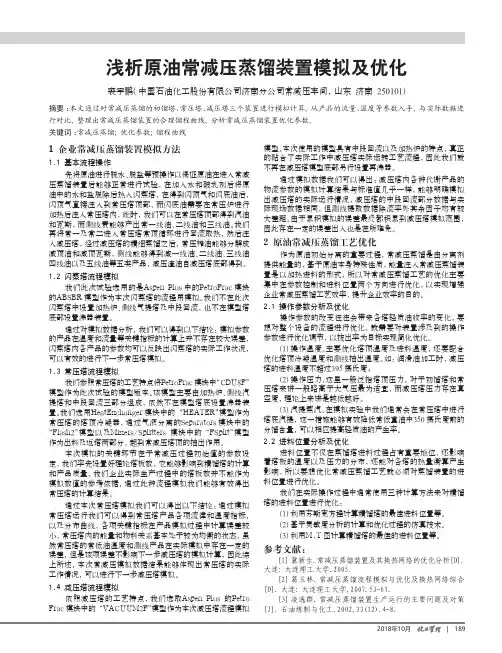
模型。
本次使用的模型具有中段回流以及加热炉的特点,真正的贴合了实际工作中减压塔实际运转工艺流程,因此我们就不再在减压塔模型底部另行设置再沸器。
通过模拟数据我们可以得出:减压塔内各种代谢产品的物流参数的模拟计算结果与标准值几乎一样,能够明确模拟出减压塔的实际运行情况,减压塔的中段回流部分数据与实际现场数据相同,但测线提取数据除流率外其余因子均有较大差距。
由于累积模拟的误差最终都积累到减压塔模拟范围,因此存在一定的误差出入也是在所难免。
2 原油常减压蒸馏工艺优化作为原油初始分离的重要过程,常减压蒸馏是由分离剂提供能量的,基于原油本身特殊性质,能量注入常减压蒸馏装置是以加热进料的形式,所以对常减压蒸馏工艺的优化主要集中在参数控制和进料位置两个方向进行优化,以实现增强企业常减压蒸馏工艺效率,提升企业效率的目的。
2.1 操作参数分析及优化操作参数的改变往往会带来各塔轻质油收率的变化,要想对整个设备的流程进行优化,就需要对装置涉及到的操作参数进行优化调节,以拔出率为目标实现简化优化。
(1)操作温度。
主要优化塔顶温度及进料温度,还要配合优化塔顶冷凝温度和测线抽出温度。
如:润滑油加工时,减压塔的进料温度不超过395摄氏度;(2)操作压力。
这里一般泛指塔顶压力,对于初馏塔和常压塔来讲一般略高于大气压最为适宜,而减压塔压力存在真空度,理论上来讲是越低越好。
(3)汽提蒸汽。
在模拟实验中我们通常会在常压塔中进行塔底汽提,这一措施能够有效降低常低重油中350摄氏度前的分馏含量,可以相应提高轻质油的产生率。
2.2 进料位置分析及优化进料位置不仅在蒸馏塔进料过程占有重要地位,还影响着塔板的温度以及压力的分布,还能对各塔的热量衡算产生影响,所以要想优化常减压蒸馏工艺就必须对蒸馏装置的进料位置进行优化。
我们在实际操作过程中通常使用三种计算方法来对精馏塔的进料位置进行优化:(1)利用芬斯克方程计算精馏塔的最佳进料位置等。
(2)基于灵敏度分析的计算和优化过程的仿真技术。
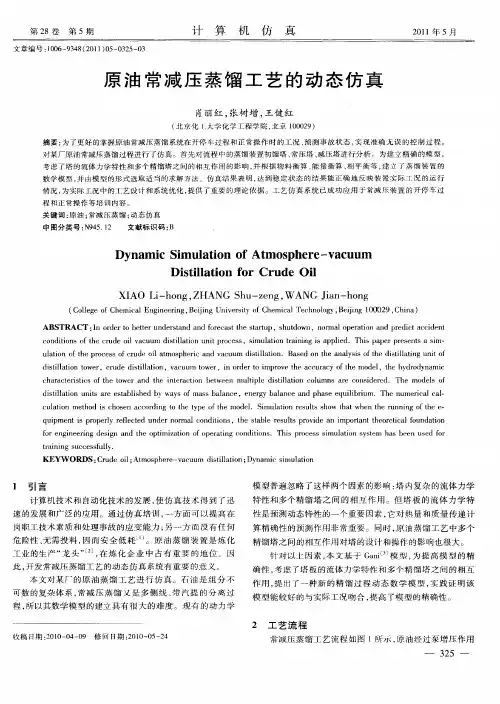
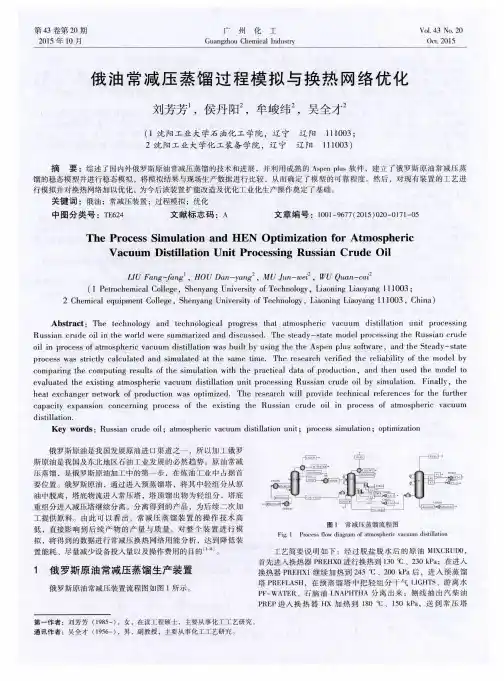
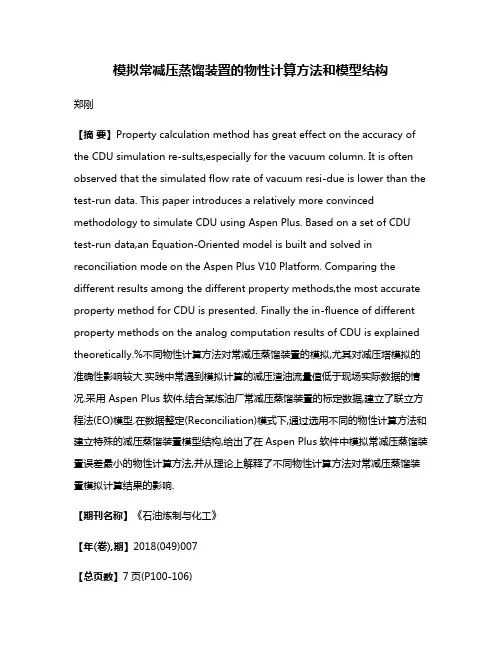
模拟常减压蒸馏装置的物性计算方法和模型结构郑刚【摘要】Property calculation method has great effect on the accuracy of the CDU simulation re-sults,especially for the vacuum column. It is often observed that the simulated flow rate of vacuum resi-due is lower than the test-run data. This paper introduces a relatively more convinced methodology to simulate CDU using Aspen Plus. Based on a set of CDU test-run data,an Equation-Oriented model is built and solved in reconciliation mode on the Aspen Plus V10 Platform. Comparing the different results among the different property methods,the most accurate property method for CDU is presented. Finally the in-fluence of different property methods on the analog computation results of CDU is explained theoretically.%不同物性计算方法对常减压蒸馏装置的模拟,尤其对减压塔模拟的准确性影响较大.实践中常遇到模拟计算的减压渣油流量值低于现场实际数据的情况.采用 Aspen Plus 软件,结合某炼油厂常减压蒸馏装置的标定数据,建立了联立方程法(EO)模型.在数据整定(Reconciliation)模式下,通过选用不同的物性计算方法和建立特殊的减压蒸馏装置模型结构,给出了在Aspen Plus软件中模拟常减压蒸馏装置误差最小的物性计算方法,并从理论上解释了不同物性计算方法对常减压蒸馏装置模拟计算结果的影响.【期刊名称】《石油炼制与化工》【年(卷),期】2018(049)007【总页数】7页(P100-106)【关键词】常减压蒸馏;流程模拟;物性计算方法;Maxwell-Bonnell;序贯模块法;联立方程法;减压深拔【作者】郑刚【作者单位】中国石油化工股份有限公司炼油事业部,北京 100728【正文语种】中文随着计算机软硬件技术的高速发展,流程模拟技术已逐渐被大专院校、研究设计单位、企业各级管理部门及工艺工程师所掌握。
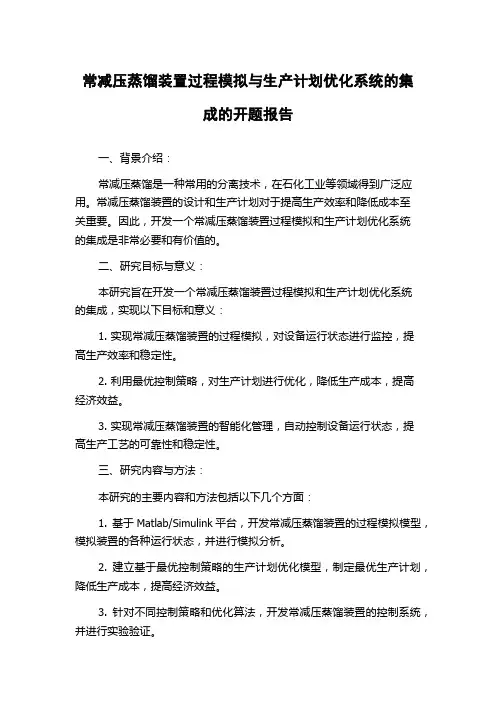
常减压蒸馏装置过程模拟与生产计划优化系统的集成的开题报告一、背景介绍:常减压蒸馏是一种常用的分离技术,在石化工业等领域得到广泛应用。
常减压蒸馏装置的设计和生产计划对于提高生产效率和降低成本至关重要。
因此,开发一个常减压蒸馏装置过程模拟和生产计划优化系统的集成是非常必要和有价值的。
二、研究目标与意义:本研究旨在开发一个常减压蒸馏装置过程模拟和生产计划优化系统的集成,实现以下目标和意义:1. 实现常减压蒸馏装置的过程模拟,对设备运行状态进行监控,提高生产效率和稳定性。
2. 利用最优控制策略,对生产计划进行优化,降低生产成本,提高经济效益。
3. 实现常减压蒸馏装置的智能化管理,自动控制设备运行状态,提高生产工艺的可靠性和稳定性。
三、研究内容与方法:本研究的主要内容和方法包括以下几个方面:1. 基于Matlab/Simulink平台,开发常减压蒸馏装置的过程模拟模型,模拟装置的各种运行状态,并进行模拟分析。
2. 建立基于最优控制策略的生产计划优化模型,制定最优生产计划,降低生产成本,提高经济效益。
3. 针对不同控制策略和优化算法,开发常减压蒸馏装置的控制系统,并进行实验验证。
4. 开发常减压蒸馏装置的智能化管理系统,实现自动控制装置的运行状态,提高生产工艺的可靠性和稳定性。
四、预期研究成果:本研究预计实现以下研究成果:1. 建立常减压蒸馏装置的过程模拟模型,对装置的各种运行状态进行分析和优化。
2. 建立基于最优控制策略的生产计划优化模型,制定最优生产计划,降低生产成本,提高经济效益。
3. 开发常减压蒸馏装置的控制系统,并进行实验验证。
4. 开发常减压蒸馏装置的智能化管理系统,实现自动控制装置的运行状态,提高生产工艺的可靠性和稳定性。
五、研究进度及计划:本研究的进度计划如下:1. 第一阶段:文献综述和方案制定。
预计完成时间:1个月。
2. 第二阶段:常减压蒸馏装置的过程模拟和实验验证。
预计完成时间:2个月。


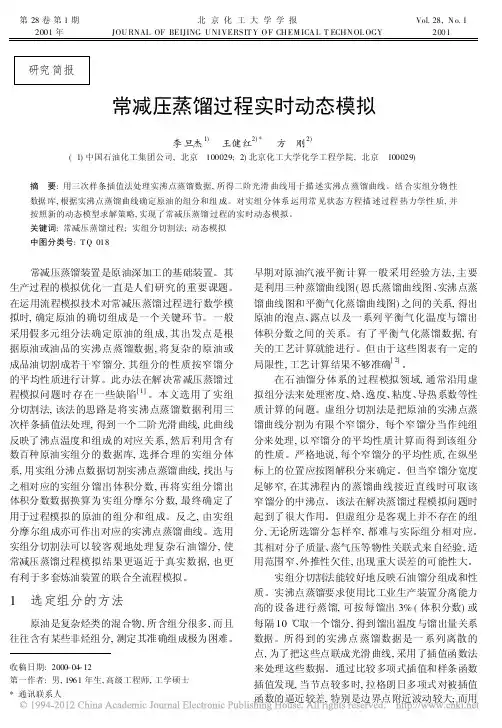
![常减压装置流程模拟与优化案例分析 [兼容模式]](https://uimg.taocdn.com/b4cfa4c9c77da26925c5b07a.webp)
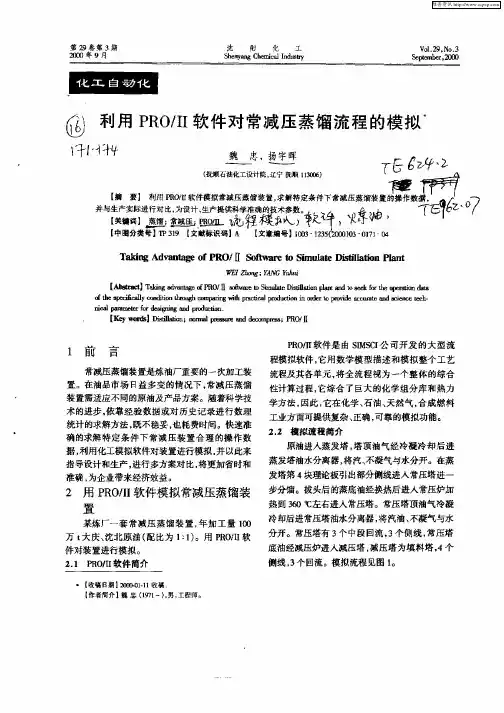
流程模拟技术在常减压蒸馏中的应用
流程模拟技术是指使用计算机技术模拟现实工艺流程,其可以模
拟复杂的化学反应、物流运输、能量传输等过程。
在常减压蒸馏中,
流程模拟技术可以帮助工程师优化操作流程,提高生产效率和产品质量。
经过流程模拟技术的帮助,工程师可以模拟不同的操作条件,如
不同的温度、压力、流量等,以评估其对蒸馏过程的影响。
这可以帮
助工程师快速找到最佳操作条件,以减少能源消耗和提高产量。
此外,流程模拟技术还可以应用于参数可视化,以便工程师全面了解蒸馏过
程中的各种参数和特性,并及时调整操作策略。
流程模拟技术还可以模拟分离过程中的传质和传热过程,以更好
地了解物质在不同阶段的运动规律。
这对于生产高质量制品尤其重要。
总之,流程模拟技术是常减压蒸馏过程中的一种重要应用。
通过
模拟不同的操作条件和特性,工程师可以更好地了解蒸馏过程中的各
种参数和特性,并优化操作流程以提高生产效率和产品质量。
流程模拟技术在常减压蒸馏装置上的应用常减压蒸馏装置是一种常见的化工装置,通常用于分离混合物中的组分。
在实际运行中,为了保证装置的运行效率和安全性,需要对其进行流程模拟。
流程模拟技术是一种基于计算机仿真的技术,可以模拟装置的运行过程,预测装置的性能和行为。
常减压蒸馏装置的流程模拟技术主要应用于以下方面:
1. 优化设计:通过对装置进行流程模拟,可以分析并优化装置
的结构和参数,以提高其分离效率和经济性。
2. 运行监控:流程模拟技术可以对装置的运行过程进行实时监
控和预测,及时发现并解决问题,保证装置的安全稳定运行。
3. 故障诊断:对于装置出现故障的情况,流程模拟技术可以模
拟出故障的原因和位置,为维修提供有力的支持。
4. 装置调试:在装置建成后,流程模拟技术可以帮助工程师们
进行调试和优化,以确保装置能够正常运行。
总之,流程模拟技术在常减压蒸馏装置上的应用具有重要的意义,可以提高装置的效率和安全性,减少生产成本,更好地服务于化工企业的发展。
- 1 -。
减压蒸馏单元仿真软件说明书北京欧倍尔软件技术开发有限公司2021年12月目录第一章软件简介 (1)1.1 概述 (1)1.2 软件特色 (1)第二章软件操作说明 (2)2.1 软件启动 (2)2.2 软件操作 (3)2.2.1 功能介绍 (3)2.2.2 界面介绍 (3)2.3 实验操作 (5)第三章注意事项 (20)3.1 软件运行注意事项及常见问题 (20)3.1.1 软件运行注意事项 (20)3.1.2 其中容易被杀毒软件阻止的程序 (21)3.2安装过程中常见问题 (22)3.2.1 控件注册失败 (22)第一章软件简介1.1 概述本软件是化学基础实验教育信息化建设项目,旨在为本科院校化学相关专业的学生提供一个三维的、高仿真度的、高交互操作的、全程参与式的、可提供实时信息反馈与操作指导的、虚拟的基础化学模拟操作平台,使学生通过在本平台上的操作练习,进一步熟悉专业基础知识、了解基础实验室实验环境、培训基本动手能力,为进行实际实验奠定良好基础。
本平台采用虚拟现实技术,依据实验室实际布局搭建模型,按实际实验过程完成交互,完整再现了基础实验室的实验操作过程。
每个实验操作配有评分系统,提示实验操作的正确操作及实验过程中的注意事项,3D操作画面具有很强的环境真实感、操作灵活性和独立自主性,学生可查看到实验仪器的各个部分,解决了实际实验过程中的某些盲点,为学生提供了一个自主发挥的实验舞台,特别有利于调动学生动脑思考,培养学生的动手能力,同时也增强了学习的趣味性。
该平台为学生提供了一个自主发挥的平台,也为实验“互动式”预习、“翻转课堂”等新型教育方式转化到基础化学实验中来提供了一条新思路、新方法及新手段,必将对促进本科化学实验教育教学的改革与发展起到积极的促进作用。
1.2 软件特色本软件的特色主要有以下几个方面:(1)虚拟现实技术利用电脑模拟产生一个三维空间的虚拟世界,构建高度仿真的虚拟实验环境和实验对象,提供使用者关于视觉、听觉、触觉等感官的模拟,让使用者如同身历其境一般,可以及时、没有限制地360°旋转观察三维空间内的事物,界面友好,互动操作,形式活泼。